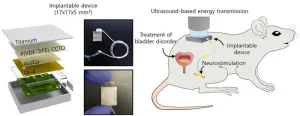(Press-News.org)
Medical technology innovations achieved by integrating science and medicine have improved the quality of life for patients. Especially noteworthy is the emergence of electronic devices implanted in the body, such as in the heart or brain, which enable real-time measurement and regulation of physiological signals, presenting new solutions for challenging conditions like Parkinson's disease. However, technical constraints have hindered the semi-permanent use of electronic devices after their implantation.
A collaborative research team led by Professor Sung-Min Park from the Departments of Convergence IT Engineering, Mechanical Engineering, and Electrical Engineering, and the School of Interdisciplinary Bioscience and Bioengineering at POSTECH, alongside Jiho Lee, enrolled in the MS/Ph.D. program, and Professor Sang-Woo Kim from Yonsei University's Department of Materials Science and Engineering, together with Dr. Young-Jun Kim and MS/Ph.D. student Joon-Ha Hwang from Sungkyunkwan University, has achieved a groundbreaking development. They've created electrostatic materials that function even with extremely weak ultrasound, heralding the era of permanent implantable electronic devices in biomedicine. This research has been published in the international academic journal Advanced Materials.
Patients with implanted devices need to undergo periodic surgeries for battery replacement. This process carries a significant risk of complications and imposes both economic and physical burdens on patients. Recent research explores implantable medical devices that operate wirelessly, yet finding a safe energy source and protective materials remains challenging. Presently, titanium (Ti) is used due to its biocompatibility and durability. However, radio waves cannot pass through this metal, necessitating a separate antenna for wireless power transmission. Consequently, this enlarges the device size, creating more discomfort for patients.
The research team addresses this issue by opting for ultrasound, a safety-validated method in various medical fields for diagnoses and treatments, instead of radio waves. They developed an electrostatic material capable of responding to weak ultrasound by utilizing a composite of high dielectric polymers (P(VDF-TrFE)) and a high dielectric constant ceramic material known as calcium copper titanate (CCTO, CaCu3Ti4O12). This material generates static electricity through friction between its material layers, producing effective electrical energy, and possesses an extremely low output impedence, facilitating efficient transmission of the generated electricity.
Using this technology, the research team created an implantable neurological stimulator powered by ultrasound-based energy transmission, eliminating the need for batteries. This was confirmed through experimental validation. In animal model trials, the device was activated even at standard imaging ultrasound levels (500 mW/cm2), imposing minimal strain on the human body. Furthermore, it effectively mitigated symptoms related to abnormal urination caused by overactive bladder disorders through nerve stimulation.
Professor Sung-Min Park stated: “We have addressed the challenges in the field of implantable medical devices using ultrasound-based energy transmission technology that is harmless to the human body. This research serves as a case of introducing advanced material technology into medical devices, and we anticipate that it will promote the emergence of a next-generation medical industry, including the treatment of intractable diseases using implantable devices.”
Professor Sang-Woo Kim remarked: “Devices manufactured based on highly biocompatible materials exhibit excellent mechanical and chemical stability, making them suitable for treating various diseases requiring long-term therapy. Non-battery, miniaturized components with established long-term stability are expected to bring forth new innovations in the market of human-insertable medical devices.”
The research was conducted with support from the Research Leader Program, Pioneer Program of Future Technology, and Bio & Medical Technology Development Program by the National Research Foundation of Korea and the Ministry of Science and ICT, along with Yonsei Fellowship.
END
LOS ANGELES — Hearing loss affects approximately 40 million American adults, yet only one in 10 people who need hearing aids use them, research shows.
Those who don’t use hearing aids but should may want to make wearing them one of their New Year’s resolutions, according to a new study from Keck Medicine of USC published today in The Lancet Healthy Longevity.
“We found that adults with hearing loss who regularly used hearing aids had a 24% lower risk of mortality than those who never wore them,” ...
Australian researchers have successfully trialled a novel experiment to address offensive and rude comments in operating theatres by placing ‘eye’ signage in surgical rooms.
The eye images, attached to the walls of an Adelaide orthopaedic hospital’s operating theatre without any explanation, had the desired effect in markedly reducing poor behaviour among surgical teams.
Lead researcher University of South Australia Professor Cheri Ostroff attributed the result to a perception of being “watched”, even though the eyes were not real.
The three-month experiment ...
The avocado has soared to unprecedented heights of popularity, gracing the plates of toast enthusiasts and health-conscious individuals worldwide. But what are the overlooked consequences of our latest food obsession?
“The avocado has come to represent so much more than just a fruit. It’s wrapped up with ideas of generational conflict, environmental chaos and social injustice. Over the last century, through careful marketing, it has evolved into a commodity crop with a huge social media following.” says Honor May Eldridge, a food policy expert who works to promote sustainable agriculture around the ...
CLEVELAND, Ohio – Jonathan Stamler, MD, has been named a Fellow of the National Academy of Inventors (NAI). Dr. Stamler is the co-founder and president of Harrington Discovery Institute at University Hospitals (UH), and the Robert S. and Sylvia K. Reitman Family Foundation Distinguished Professor of Cardiovascular Innovation at the Case Western Reserve University School of Medicine.
Election as an Academy Fellow is the highest professional distinction awarded solely to inventors and the 2023 Class of Fellows ...
Suzanne Lenhart, Chancellor’s Professor in the Department of Mathematics, will join a storied list of honored speakers to deliver the Josiah Willard Gibbs Lecture at the world’s largest annual math gathering, the American Mathematics Society (AMS) Joint Mathematics Meetings (JMM2024), taking place January 3–6, 2024, in San Francisco.
JMM2024 brings researchers from 20 national and international partner associations to share the latest developments in mathematical thought and application.
Lenhart is the ...
BIRMINGHAM, Ala. – The blood-brain barrier blocks the entry of antibodies into the brain. This limits the potential use of antibody therapeutics to treat brain diseases, such as brain tumors.
Elsewhere in the body, more than 100 United States Food and Drug Administration-approved therapeutic antibodies are used by medical teams to treat cancers and autoimmune, infectious and metabolic diseases. Finding ways to transport therapeutic antibodies across the blood-brain barrier — from the peripheral blood stream into the central nervous system — could create effective treatments that act in the brain.
In a study published in the journal Frontiers in Cell and Developmental ...
Today, the U.S. Department of Energy (DOE) announced the issuance of a Request for Proposals (RFPs) for the competitive selection of a management and operating contractor for Fermi National Accelerator Laboratory (FNAL).
FNAL is a single-purpose laboratory that leads the nation in the construction and operation of world-leading accelerator and detector facilities and in the development of the underlying technology for particle physics research. Its mission is centered on delivering breakthrough science and technology ...
For nearly 20 years, Stephen Ball has been a man on a mission: helping older Missourians stay healthy and get stronger through physical activity.
In 2005, the professor in the University of Missouri College of Health Sciences helped created a program called Stay Strong Stay Healthy (SSSH). Since then, the eight-week strength training program has helped more than 20,000 older adults across five states. Participants aged 60 and up are taught how to safely complete exercises — including squats, bicep curls and lunges — in a comfortable, friendly environment.
“One thing I always ...
Researchers from Rutgers and other institutions have uncovered significant variations in how inflammatory bowel disease (IBD) affects people of different races, sexes and places of birth.
The study, published in Gastro Hep Advances, may assist caregivers and help shed light on how diet, lifestyle and genetics can affect the development and disease course of IBD, a term for two conditions – Crohn’s disease and ulcerative colitis – that cause chronic inflammation in the gastrointestinal tract.
“IBD has historically been a disease of Caucasian populations in Europe and North America, but now we’re seeing it among all races and in people all over the ...
Pregnancy weight and biochemical markers measured in blood from women with gestational diabetes mellitus (GDM) were related to increased risk of poor pregnancy outcomes, suggesting a new direction for precision diagnostics, according to researchers.
The study led by Ellen C. Francis, an assistant professor in the Department of Biostatistics and Epidemiology at Rutgers School of Public Health, and published in Communications Medicine, evaluated the diagnostic value of these markers before or at the time of screening ...






